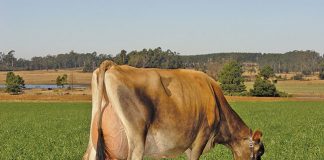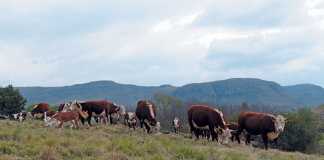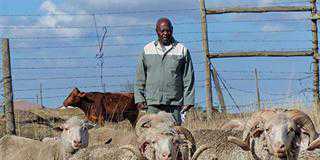Internal parasites
- Intestinal roundworms: Warm weather during winter contributed to worm eggs hatching and farmers should be aware of wireworm infestations during spring, especially on irrigated pastures. Regular inspection of the colour of mucous membranes should help them to be proactive in preventing losses due to this parasite. Resistance of parasites to anthelmintics was also reported. Ask your vet how to establish which drug groups are still able to control the parasites on your farm.
- Liver fluke and conical fluke infestation: Some animals came into contact with the parasites’ intermediate hosts – water and mud snails – during winter. As water bodies dry up, the snails concentrate in the remaining water and the plants there are heavily infested with meta-cercariae. Be aware of clinical signs such as bottle jaw and diarrhoea.
- Tapeworms: Cattle infected with measles were reported. Huge financial losses may occur if infected animals are sent to abattoirs for slaughter. Biosecurity measures should be put in place to prevent animals becoming infected.
- Parafilaria: Reports were received of cattle in the bushveld infected with this parasite. Cattle sent for slaughter should be treated at least 70 days before slaughter to prevent trimming of lesions at the abattoir.
External parasites
- Ticks: Blue ticks, which transmit diseases such as African and Asiatic red water and anaplasmosis, were reported in many areas. Now is the time to plan your tick control programme and which actives to use for the coming spring and summer season.
- Remember always to keep enzootic stability against tick-borne diseases at the back of your mind. Farmers should know which acaricidal active groups are still able to control blue ticks on their cattle.
- Lice: As many parts of SA are experiencing drought conditions and animals are in poor condition, farmers should control these parasites.
- Flies, midges and mosquitoes: These insects are carriers of diseases such as blue tongue, Rift Valley Fever, three-day stiff sickness, Wesselsbron and African horse sickness. Farmers should vaccinate before outbreaks occur.
Tick-transmitted diseases
- Red water: Cases of African and Asiatic red water were reported in many areas of the country. Vaccinate against these diseases to prevent losses.
- Anaplasmosis: The rickettsia causing this disease is transmitted by blue ticks as well as biting flies and injection needles. Preventative vaccination of animals will stop losses.
Bacterial diseases
- Clostridial diseases: Gas gangrene, red and blood gut, pulpy kidney, botulism and tetanus have all been reported. Good vaccines against all these diseases are available.
- Other bacterial diseases: Reports of mortalities and diseases caused by Escherichia coli and Salmonella spp. (diarrhoea), Mannheimia haemolytica and Pasteurella multocida, Histophilus somni(pneumonia,) Coxiella burnetti (abortions), Trueperella pyogenes and Corynebacterium ovis (abscesses) were received. Consult your vet on how to diagnose and control these diseases.
Viral diseases
- Respiratory diseases: During winter respiratory diseases were rife. They can, however, be controlled by giving viral vaccines containing antigens, such as parainfluenza 3 (PI 3), infectious bovine rhinotracheitis (IBR) virus, bovine viral diarrhoea (BVD) virus and bovine respiratory syncytial virus (BRSV). Consult your vet.
- Bovine malignant catarrh (snotsiekte): As there’s no preventative vaccine, this disease can only be contained by excellent biosecurity measures and good neighbourliness. Be aware of the fact that there are two types of carriers of this disease – wildebeest and sheep.
- Leucosis: As with snotsiekte, there’s no vaccine available for this virus. Be careful when buying in animals as they may be latent carriers.
Venereal diseases
Trichomonosis, Vibriosis and Brucellosis cost farmers millions of rands in losses. Strict biosecurity measures should always be in place to prevent these diseases coming onto farms. If they’re already, control programmes should be discussed with your vet.
Poisonings
Urea, tulip, Lantana, Inkberry, Gifblaar, acidosis (maize overload), alkalosis (lupin overload), bur weed, nitrate and Cynanchum (klimop) were reported, as was an overdose of trace minerals. It’s important that farmers read the packet inserts of products, weigh the animals, calibrate the syringes, use sterile needles and instruments and inject animals properly.
Nutrition
Due to winter and drought conditions, energy and protein deficiencies were reported from many areas. The following deficiencies were also reported: calcium, phosphorus, copper, selenium, zinc and Vitamin A.
Metabolic diseases
Ketosis, pregnancy toxaemia (domsiekte), milk fever and magnesium staggers were reported.
Feedlot Report
Sheep feedlots
- Urolithiasis is common this time of the year. Grazing conditions and licks given are likely contributing factors and many losses are seen due to this condition.
- Pneumonia cases were few in spite of fluctuating weather conditions. Dust plays a major role this time of the year in the occurrence of respiratory disease.
- Adaptation problems, with mortalities due to acidosis, enteritis and blood gut, are usually seen in lambs in poor condition arriving at feedlots.
- Mortality due to pulpy kidney is an ongoing problem in lambs that weren’t vaccinated against this disease at farm level.
Cattle feedlots
- Cattle arriving from poor grazing conditions struggle to adapt and also have mineral deficiencies. Many deaths occurred among such animals. The rumen flora of cattle that had been on poor grazing has changed so much it takes a long period to adapt, even on weak rations. The condition of some deteriorate even further as the animal has no reserves, and is unable to absorb enough nutritional substances from the ration due to the atrophy that’s taken place in the gastro-intestinal tract.
- Some C-grade cattle in weak condition struggled to adapt, got weaker and died. Some went down in trucks during transport and succumbed as a result of injury.
- Mortalities due to acidosis and red gut were common, especially in areas where the wind blew a lot during the day.
View the disease trends in your province.













